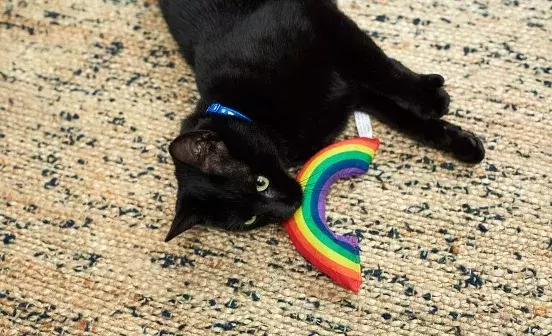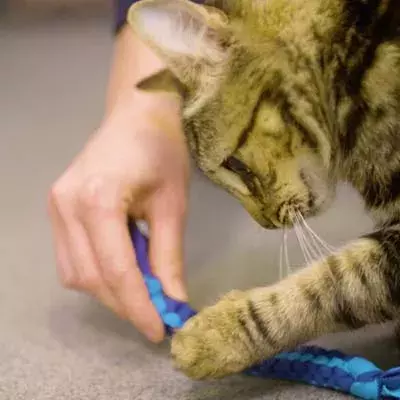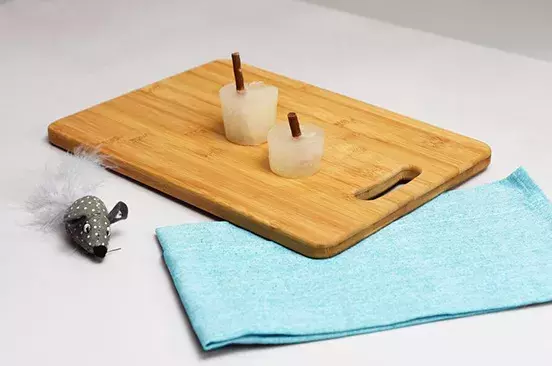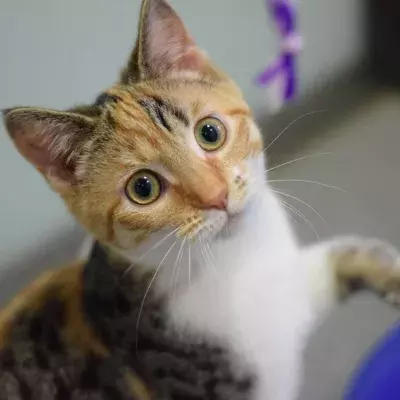Play is a great source of positive mental stimulation for cats. The physical exercise is good for cats with high energy levels that need to blow off some steam, as well as cats who are overweight, or might need encouragement to move about more.
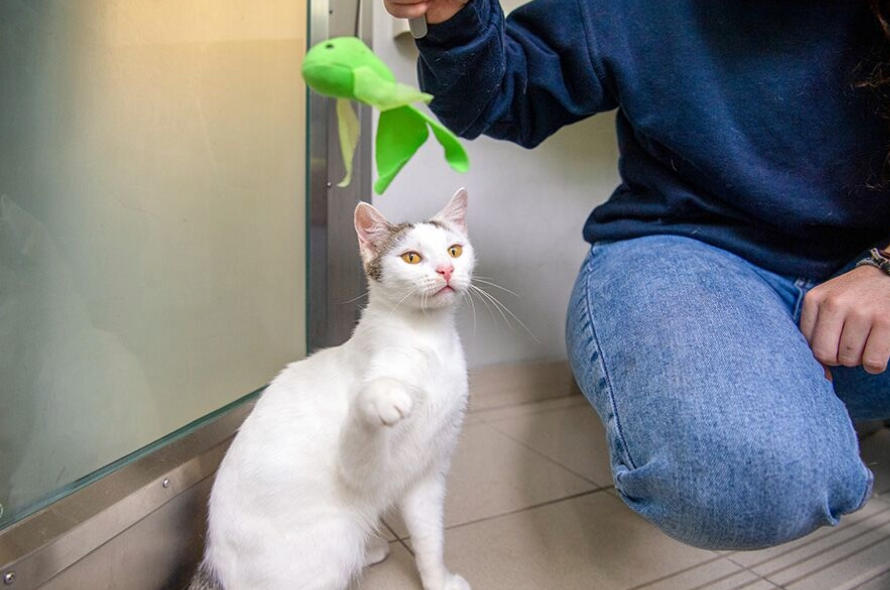
Play time may also encourage your cat to direct their perfectly natural hunting instincts towards ‘safe’ objects, rather than live prey, or your hands or feet. This means that lots of suitable play can be useful for managing cats that tend to either hunt wildlife or their humans!
For cats that are very active or don’t like to be touched or stroked too much, play is also a good way to interact and bond with them, in a way that they find enjoyable and might be more comfortable with.
What cat toys are best to use, and how should I play with my cat?
There are a few different types of play your cat might enjoy:
- Some cats may prefer to play with people (‘interactive play’)
- Some cats might like to play with toys by themselves (‘self-play’)
- Some cats will enjoy a combination of both, at different times.
When hunting, cats may have a preference for, or are just better at, catching certain types of prey (for example mice rather than reptiles, or moths rather than birds). Therefore, a little bit of trial and error may be required to work out what types of toys your cat prefers to play with, and how they enjoy playing with them.
‘Interactive’ play
Cats who are in the mood to play are likely to become very alert and responsive. This means that the best toys to use when playing with your cat are ones that allow you to operate the toy at a ‘safe’ distance from them. A wand or ‘fishing rod’ with a toy on the end of some string attached to a stick is ideal and can also be moved in a way that mimics the movement of prey, which will encourage your cat to stalk, chase and pounce on the toy.
The best types of toys to have on the end of the string are those which look, feel and sometimes even smell, like real prey. For example, mouse-sized items made of soft materials, or a bundle of feathers tied together can look and feel like the real thing. By using toys that stimulate more of your cat’s senses (e.g., sight, smell, sound, touch) as well as allowing your cat to go through the different parts of their natural predatory sequence (stalk, chase, pounce, catch, poke and bat, and then bite), your cat will get the most benefit out of the session. Cats can be left feeling frustrated if they are never able to catch or ‘kill’ the ‘prey’ they are playing with. This is why we wouldn’t recommend using laser pointers to play with your cat as the cat doesn’t get any kind of positive outcome or sense of achievement and can actually become quite frustrated.
How to move the toy
When moving the wand or ‘fishing rod' toy about, try to mimic how a bird or mouse would move, for example short, sometimes erratic bursts of movement followed by moments of inactivity. Moving the toy in this way is most likely to encourage your cat to be interested and engaged in the game. During a play session, your cat might also enjoy having treats thrown in different places to chase after and then eat. This will also help to keep your cat engaged and interested in playing. In the wild, cats may have to try to reach prey within burrows or holes in trees, and so recreating this type of activity for your cat at home can be particularly exciting for them. For example, using a ‘hidden’ toy (e.g., a wand toy moved about under a rug, or ping pong balls that are placed inside a box with holes in) can be particularly stimulating for some cats as they can use their paws to ‘scoop out’, paw at or pounce on the objects.
When to change toys
A usual hunting ‘attack’ would normally be over quite quickly, as the cat would either catch the prey and kill it or lose it. This is why some cats will initially be very excited by a new toy, but will soon lose interest (because when hunting, they would have either lost the prey or caught and killed it by now). To avoid your cat becoming bored, it’s therefore a great idea to have several different toys that you can change between during a play session. If your cat particularly enjoys chasing after insects, a thin wire with a small bit of cardboard or a few twigs attached to one end is ideal. When you hold the other end and move the wire about, it moves a lot like a small insect. You can buy these toys, sometimes called “cat dancers’ but they are also simple enough to make yourself. To help keep the toys interesting, it’s a good idea to store them away and only bring them out during play sessions. Other ‘self-play’ toys can be left out, but these should be changed regularly to help keep them exciting for your cat.
‘Self-play’ toys
Small bird or mouse-sized soft toys which contain herbs that naturally attract cats, such as valerian or catnip, can be good for your cat to play with alone. You can also purchase these herbs separately in either a dried or spray form, and then either rub or spray them over toys. This is also a good way to ‘top up’ the smell of old catnip toys that have been washed or have lost some of their potency over time. To keep these items exciting, it’s a good idea to rotate them with different versions and place them in different locations around the house so your cat has to go ‘hunting’ for them.
You can also buy battery-operated cat toys with moveable parts; just make sure your cat has the chance to ‘catch’ and ‘kill’ the moving object at some point. Remember that your cat may start to get bored of the toy after a period of time, so it’s best to bring it out for short sessions and then store it away to keep it new and exciting.
How to make fun, cheap toys for your cat
You don’t need to spend lots of money when buying cat toys. You can make cat toys with everyday household items such as the insides of toilet rolls, empty cardboard and egg boxes, empty plastic bottles or yoghurt pots.
What should I avoid doing when playing with my cat?
As mentioned above, if your cat isn’t able to go through the stages of hunting and then catching and killing their ‘prey’, they can become frustrated. For this reason, toys such as laser pens are not ideal, because your cat is only ever able to stalk and pounce on the laser and never actually ‘catch’ or ‘kill’ it.
While we don’t recommend them, if laser pens are used, it’s a good idea to make sure that the laser appears from a predictable place or location (e.g., from under a sofa), rather than randomly appearing from anywhere. You could also add to the experience by throwing a small mouse-like object or some treats for your cat to catch once they’ve ‘caught’ the laser.
You should also avoid leaving string/fishing rod toys out when you’re not around as your cat may get tangled up in them. This also applies to any other toys that are not necessarily ‘safe’ for your cat to be left with unsupervised. If in doubt, don’t leave a toy out.
How do I avoid getting bitten or scratched when playing with my cat?
Your cat can get very excited while playing, so you should try not to touch them or handle them as they might be more likely to bite or scratch you. Using an extra-long fishing rod toy will also help to make sure your cat is far enough away from you whilst in ‘play mode’ so that your cat doesn’t accidentally confuse you with their ‘prey’.
You should also avoid using your hands or feet to play with your cat, even if your cat is a kitten and their teeth and claws are relatively harmless. Once the cat is used to playing in this way, it can be a hard habit to break, and this kind of behaviour with bigger, sharper teeth and claws can easily lead to an injury, particularly as the cat gets older.
My cat doesn’t seem interested in playing, is there anything I can do to encourage them?
Some cats may be much more playful or predatory than others. Older cats may naturally slow down and some may start to lose interest in playing. However, play is potentially beneficial to cats of all ages, and it may just be that your cat has specific requirements when it comes to playing with toys, or just needs a bit more encouragement than they used to.
If your cat is not physically unwell or stressed, but seems uninterested in playing with toys, it may just be worth experimenting a bit to see if there is anything that might stimulate their interest, such as:
- Use toys that look, feel and smell like real prey. Experiment with toys that are like different types of prey (i.e. insects, mice, birds etc.).
- Use wand toys that can be moved in rapid, short bursts to mimic the movement of prey – pay attention to which types of movements trigger the greatest response from your cat.
- Change toys frequently and introduce new objects regularly.
- Have some toys that only come out during play sessions so that they retain their novelty and excitement.
- During play sessions, have several toys and swap between them frequently to keep your cat excited and interested.
- Allow your cat to ‘catch’ and ‘kill’ the toys at some points.
- Throw the occasional treat for your cat to chase after and eat.
- Try using toys that contain catnip or valerian. Be careful though, as catnip affects some cats more than others, so it’s a good idea not to handle or touch them while they play with it.
- Try playing with your cat in the garden when their senses are more stimulated. Your cat is more likely to be in a predatory or playful mood in this environment.
